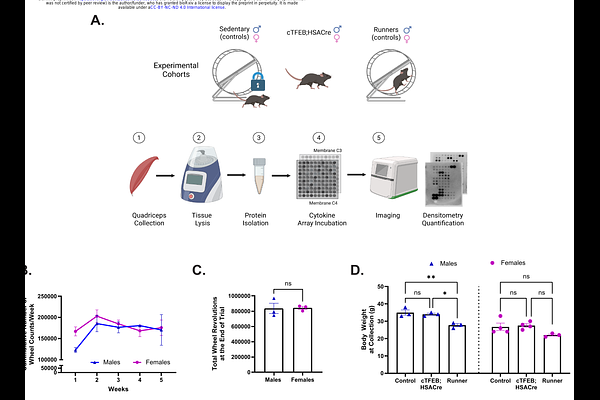Convergent Skeletal Muscle Cytokine Responses to TFEB Overexpression and Voluntary Wheel Running Reflect Sex-Based Variability in Exercise Adaptations

Convergent Skeletal Muscle Cytokine Responses to TFEB Overexpression and Voluntary Wheel Running Reflect Sex-Based Variability in Exercise Adaptations
Patterson, D. C.; Birnbaum, A.; Matthews, I.; Cortes, C. J.
AbstractEndurance exercise (running) promotes skeletal muscle remodeling through metabolic and inflammatory signaling cascades. However, the extent to which these responses are sex-dependent remains unclear. Here, we profiled cytokine responses in quadriceps muscle lysates from sedentary, voluntary wheel-running (VWR; 5 weeks), and muscle-specific TFEB-overexpressing (cTFEB;HSACre) male and female mice. Cytokine analysis revealed 40 differentially expressed factors associated with exercise and/or TFEB overexpression, many displaying sex-dimorphic expression patterns. In males, VWR induced significant increases in interleukins (e.g., IL-1, IL-1{beta}, IL-2, IL-5, IL-17) and chemokines (e.g., MCP-1, CCL5, CXCL9), as well as cytokines involved in TNF signaling (e.g., TNF, sTNFR1/2, Fas ligand). TFEB overexpression in sedentary males recapitulated many of these cytokine elevations. In contrast, female runner muscle showed limited cytokine activation, with significant changes restricted to IL-3, IL-3Rb, IL-13, and CXCL16. Both sexes exhibited a reduction in IL-4 and an increase in IGFBP-5 with running. Several additional male-specific cytokine profiling responses, including increases in IFN{gamma}, SCF, TPO, VCAM1A, and leptin, further underscored the sex-specificity of exercise-related inflammatory adaptations. These findings demonstrate that skeletal muscle cytokine responses to endurance-like stimuli are profoundly influenced by sex and suggest that male muscle exhibits a broader and/or later remodeling profile than female muscle. Our data also implicate skeletal muscle TFEB-overexpression as a partial molecular mediator of the cytokine shifts observed with exercise, particularly in males, and highlights their potential use as a new prioritization platform for exercise-associated phenotypes